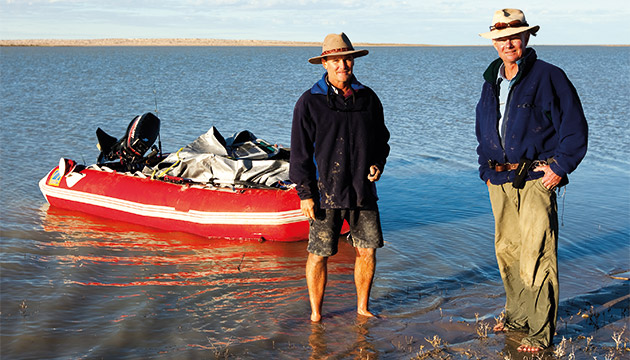Adventurers Kieran Kelly and andrew gregory take a Zodiac down the channel that funnels Queensland rivers into Lake Eyre in an attempt to swim across Australia’s largest lake.
Story By Kieran Kelly
“Are you sure you really want to do this?” Andrew asks. I look at the windblown chop, the muddy water churned into an uninviting mess. The tiny boat bucks and heaves under our bare feet. The roaring wind, straight out of the Great Australian Bight, whips whitecaps from the foam and we are drenched from the icy spray.
“Dunno. The visibility will be zero and have a look at this wind chop, will you? I wasn’t expecting this. It’s going to be freezing in there.” On either side of the Warburton Groove – the narrow channel that funnels the Queensland rivers into Lake Eyre – lonely white sand dunes roll away. It is a long way from anywhere and a strange place to be planning a swim.
It had seemed a simple plan; load a Zodiac inflatable boat onto the roof of Andrew Gregory’s Toyota troopie in Sydney, drive to Birdsville, Qld, then down to Kalamurina Wildlife Sanctuary on the Warburton River. From there we would navigate 200 kilometres downriver to the Groove and I would try to swim through it into the vast inland sea of Lake Eyre.
So far it’s gone to plan – mostly. We left Stony Crossing below Kalamurina homestead loaded with 155 litres of fuel and everything needed to keep two men alive for three weeks in the wilderness of the Tirari Desert, which straddles the northern approaches to Lake Eyre.
But as we cannon into the first of an endless number of sandbars, we realise that we are probably two months too late to be attempting this journey. The high-water marks way up the banks and the debris in the fringing coolibahs show that the river has already fallen six metres from its peak and in some places is no more than ankle-deep. And it is muddy – very muddy. On our first night attempting to make camp, I had jumped out of the boat and sunk up to my knees. Although the river had fallen substantially, to my surprise the riverbanks were saturated up to two metres above the water line. We couldn’t walk up the steep riverbanks. We couldn’t even trudge up them. We jumped in and splodged up the banks, loaded with food and gear. I was surprised at the exhaustion this brought on.
Nevertheless, boat travel on the ephemeral rivers of central Australia has had countless rewards. Colonies of fledglings greet us at every turn. Pelicans, too many to count, festoon the sandbars and gracefully take to the air on our approach. There are spoonbills and corellas in blizzards, kestrels watching our passage from high on the tree-lined banks and even colourful flashes from a breeding colony of the rare rufus night heron.
This Story is from Issue #67
Outback Magazine: Oct/Nov 2009










